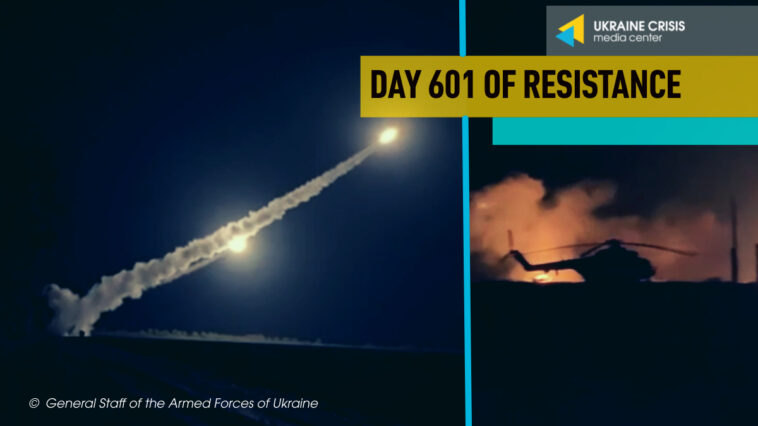Ukrainian strikes on airfields in Russian-occupied Berdyansk and Luhansk take out the largest number of Russian helicopters since the invasion. Ukraine uses U.S.-supplied long-range ATACMS missiles for the first time. The European Parliament approves a four-year financing package for Ukraine worth EUR 50 billion from 2024 to 2027.
Ukrainian strikes on airfields in Berdyansk, Luhansk take out largest number of Russian helicopters since invasion
Overnight on October 17, Ukrainian Armed Forces struck military airfields in Russian-occupied Berdyansk and Luhansk, destroying at least nine helicopters and other pieces of military equipment, including an air defense missile launcher.
This is Russia’s biggest loss of helicopters in a single episode and one of the biggest aircraft losses since the invasion. These are also one of the most successful Ukrainian strikes at Russian targets far behind the front lines.
The nighttime attacks were first confirmed by the strategic communications department (StratCom) of the office of the Commander-in-Chief of the Ukrainian Armed Forces. Overnight on October 17, the Ukrainian Armed Forces launched “successful strikes at helicopters and airfield equipment of the Russian occupying forces” near Russian-controlled Luhansk and Berdyansk, the statement said.
Later Ukraine’s Special Operations Forces said they had carried out an operation called “Dragonfly”. They said they knew that Russian forces were using airfields in Berdyansk and Luhansk and were notified that Russia had deployed “a significant number of aircraft, special equipment and ammunition” there.
After verifying the reports, they passed on the coordinates for an air strike to other units of Ukraine’s defense forces. The strike destroyed nine helicopters of various types, special equipment on the airfields, an antiaircraft missile launcher, an ammunition depot, and damaged runways, the Special Operations Forces said.
Russia’s losses in the operation amount to dozens of dead and wounded. As of Tuesday afternoon, bodies were still being pulled from the rubble.
The ammunition depot in Berdyansk detonated until 4 a.m. The detonation in Luhansk continued until 11 a.m., Ukraine’s Special Operations Forces said in a statement.
A strike on Russian air capabilities is important as Russia often uses helicopters on the front lines against Ukrainian troops, spokesperson for the Ukrainian Air Force Command Colonel Yuriy Ihnat said in a video comment to Ukrainian media.
Ukraine uses U.S.-supplied long-range ATACMS missiles for first time
Ukraine launched ATACMS missiles at Russian forces on Tuesday, marking the first time that the U.S.-provided weapons have been used since Moscow invaded the country, The Wall Street Journal said on Tuesday.
The Ukrainian military reportedly used U.S.-supplied longer-range missiles to strike the airfields near Luhansk and Berdyansk overnight on October 17. Russian Telegram channels earlier said that fragments of ATACMS missiles had been found at the site of the strike.
A small number of the missiles have been secretly sent to Ukraine in recent days, where they will augment Kyiv’s capability to carry out long-range strikes at Russian forces during an important stage of its counteroffensive, The Wall Street Journal said, citing people familiar with the matter.
The ATACMS models that were provided have a range of about 100 miles (approx. 160 km).
European Parliament approves four-year financing package for Ukraine worth EUR 50 billion
In a vote on Tuesday, the European Parliament backed a proposal by the European Commission for a EUR 50 billion facility to support Ukraine’s recovery, reconstruction and modernization from 2024. The proposal passed by a vote of 512 to 45 with 63 abstentions.
MEPs must still negotiate the aid facility with the EU member states as soon as the EU Council agrees a joint position.
In June 2023, the European Commission unveiled a new plan to help Ukraine run its day-to-day operations and fund the country’s reconstruction. Dubbed the “Ukraine Facility,” it will provide up to EUR 50 billion in financial support for Ukraine from 2024 to 2027 in loans and grants.
One of the Parliament’s key demands is that the facility uses frozen Russian assets to reconstruct Ukraine. The Parliament also strengthened the provisions on the fight against fraud, corruption, conflicts of interest and irregularities in the use of EU funds in Ukraine. Companies under oligarchic influence should not be eligible for funding, MEPs added.
MEPs amended the proposal to make the facility more transparent, requiring the creation of a web site that will track the funds granted to Ukraine for specific objectives, and the “milestones” met by the country in order to receive the aid. They also want the contributions received from third countries and international organizations to be made public.
The Ukraine Facility is part of the ongoing revision of EU’s long-term budget, for which adjustments are needed, as it has been severely depleted following the multiple crises that have occurred since 2021. MEPs insist that the Facility, along with the entire budgetary revision, should be agreed as soon as possible, as there will be no provisions for assistance to Ukraine from 2024. The package should be also integrated into next year’s annual budget, to be negotiated in November.

